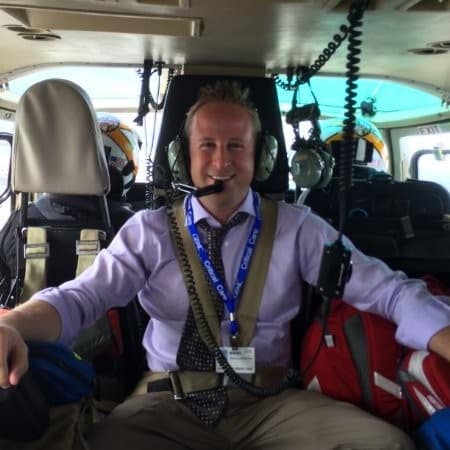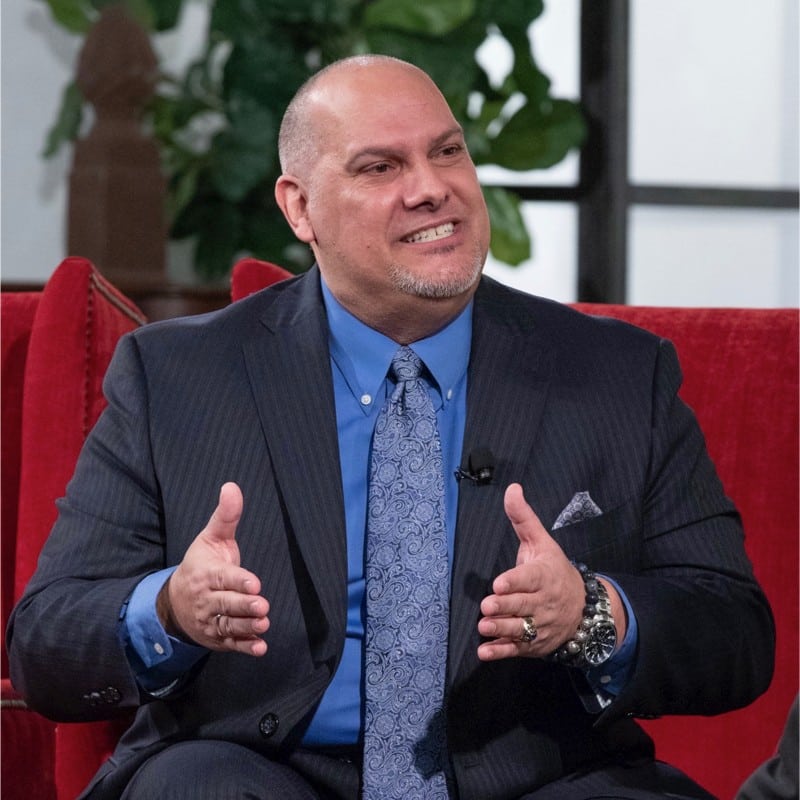
As we prepare and plan for 2021, a little foresight from industry leaders can help. Thankfully, 17 EMS industry leaders have agreed to share their insights and predictions on one or all of the following topics:
- How will big issues in EMS evolve?
- What might change or improve in 2021?
- Anything that you’re working to achieve?
Below are their responses. If you’re short on time, you can just read the text in bold in order to get the main points without complication.

Greg Friese, MS, NRP
Editorial Director, EMS1
2021 is shaping up to be a challenging year for EMS as organizations and providers continue responding to the generational challenge of COVID-19, acting to keep themselves and their families safe, preparing for mass-vaccination against the deadly coronavirus and learning to operate with the economic consequences of reduced local and state government support. Simultaneously, EMS can also be hopeful about the Emergency Triage, Treat and Transport (ET3) model and increased opportunities to treat patients in place with telemedicine. Finally, well-trained, supported and dedicated field supervisors – the middle managers of EMS – are critical to organizations that deliver high-quality patient care, have excellent employee satisfaction and are immune to the ongoing recruitment and retention crisis.

Senior Consultant & Show Host, Moore EMS Consulting
How big issues in EMS will evolve?
I believe that it will be critical for EMS organizations to continue to focus both time and resources on workforce issues. Prior to the COVID-19 pandemic, EMS agencies were struggling with significant recruitment and retention issues. The pandemic has only compounded those challenges as many individuals who previously may have considered a career in EMS decide to take other, less risky, positions. Additionally, those who have been on the front lines of the pandemic response grow weary of the risks they face every day when working and the additional concerns of bringing the illness home to their families. EMS organizations will have to evolve how they engage, interact, and support their team members. EMS providers will need not only the personal protective equipment (PPE) to protect themselves from exposure to the virus, but also emotional PPE to support their mental wellness.
What might change or improve in 2021?
I think we will continue to see an improved understanding by the broader healthcare community of the clinical and logistical abilities and resources that EMS organizations can provide with both the pandemic response but in the larger healthcare spectrum. EMS organizations are sophisticated and dynamic healthcare delivery agencies who can bridge many of the chasms in the healthcare landscape.
Anything that you’re working to achieve?
I am continuing to lead the charge, as one of the only EMS focused Human Resources Certified employment lawyers exclusively serving the EMS community, with improving employee engagement, workforce development, and employee resilience and mental wellness. I often hear that reimbursement is EMS’ biggest challenge. I think reimbursement is a significant challenge. However, these challenges have existed for all of my 30 years as an EMT and EMS organizational leader. We need to operate in the world we live in, not the one we wish we lived in.

Managing Partner, Page, Wolfberg & Wirth, LLC
Obviously, the nation and the world is in a state of flux right now, between politics, pandemic and natural disasters. It’s hard to predict the future of EMS in a “normal” year, and even more difficult in the wake of what 2020 brought. One thing that we have seen remain fairly constant, but always slightly evolving, is the government audit process. 2019 saw OIG reports regarding EMS, with some fairly immediate audit activities by the OIG, MACs and the SMRC. Some of those audits came to a screeching halt in the second quarter of 2020. But, we’ve seen an uptick in audits again, including the OIG resuming its audit activities related to its 2019 Reports. Similarly, although the MACs took a temporary hiatus on medical review audits, those audits have resumed once again. Likewise, while there was a so-called “pause” in the prior authorization model, this program has again resumed, and a recent announcement confirmed what we were all thinking for quite some time: the national-wide rollout is forthcoming.
While the EMS industry (and quite frankly all of healthcare) may have seen a respite from audit activities for about 6 months in the middle of 2020, government audits are (and will continue to be) back in full force. The government even has a wealth of new areas to audit EMS in the wake of the COVID pandemic, including, but not limited to: alternate destinations, CR and CS modifiers, COVID-specific ICD-10 codes, and CARES Act Funding. Of course, traditional medical necessity and fraud and abuse audits are always on the table and many government auditing departments are ready, willing, and able to initiate those “routine” audits once again. Although the government auditors were benevolent to front line healthcare workers like EMS in the beginning of the pandemic (being willing to forego audit activities for a short time) it seems that kindness has run dry. In the not too distant future, I believe government scrutiny through claim audits to ferret out fraud, overpayments, and improper billing practices is about to kick into high gear despite the increasing scope and breadth of the COVID pandemic we are experiencing as 2020 draws to a close. While 2020 was memorable, it is very possible that 2021 will be just as memorable, but for a very different reason. As the government faces huge debts and a change in leadership, exponential increase in audit activities focused on recovering funds into the Medicare trust fund is my bold prediction for 2021.

Chris Smetana, AS, FP-C, CCP-C, NRP
CEO, IA MED
How will big issues in EMS evolve?
One of the biggest issues we are seeing at IA MED right now is the lack of internal infrastructure for online and remote education in EMS, Fire, and Air medical agencies with the 2020 pandemic. I foresee 2021 being that drastic change and overhaul to how we deliver high-quality online education and its accessibility to healthcare clinicians. Medical education is becoming more of a forethought and less of an afterthought with the new trends.

Daniel P. Burke, NRP
EMS Program Manager, DC Department of Health
2021 will be the year of Community Paramedicine. As our healthcare systems, including EMS, have been stretched thin over the past nine months as a result of the Coronavirus Pandemic EMS has stood strong. This year we have seen EMS Providers across the country take on new roles such as administering COVID-19 testing services and flu shot clinics. Our industry has demonstrated a level of adaptability that lends itself to the advancing role of EMS Providers beyond the load-and-go of old. The next logical step is advancing the services that EMS is able to provide while keeping the patient at home or allowing the EMS provider to identify alternative and often more appropriate destinations for non-acute patients such as clinics or sobering centers. With the launch of ET3 (Emergency Treat, Triage, and Transport) expected in January, 2021 will be the first time many non-transport or alterative destination services are reimbursable through CMS.

President Elect, International Association of EMS Chiefs (IAEMSC)
How will big issues in EMS evolve?
There is a huge need for development at the micro/macro level of EMS systems. We have many services but not enough systems. Many people confuse an EMS service and to a greater extension an EMS service delivery model with a system. The two are not the same.
What might change or improve in 2021?
Greater coordination and integration between healthcare systems and EMS. If we have learned anything from the pandemic there are a whole host of vulnerabilities to the provision of EMS and out of hospital care. The very nature of the pandemic caused these fragilities to be exploited. These was especially true for people of color and for those who were socially and economically disadvantaged.
Anything that you’re working to achieve?
Working to develop systems of care that improve and sustain patient outcomes and survivability and within that micro systems (opioid systems, stroke systems, neurotrauma, etc.). There is incredible amount of work that needs to be accomplished, but if we put our shoulder to the wheel, we can reduce death and disability for vulnerable populations.

Thomas Beers, MPA, EMT-P, NHDP
EMS Manager, Cleveland Clinic
Big Issues: “The current payment scheme that is pervasive within a majority of publicly funded EMS agencies, colloquially referred to as “you call, we haul”, is non-sustainable. Federal and state oversight and analysis of quality EMS services and then paying appropriately for quality EMS services, is ever increasing. Meaning, if EMS agencies continue to transport patients that they know do not need an emergency transport, simply for the opportunity to collect a pittance for the transport, will eventually bleed federal and state healthcare dollars dry. The tap will eventually be turned off by hawkish legislators. As an industry we need to focus more on the morally correct option of advising citizens of their choices other than emergency transport, which in-turn reduces the burden on an already overloaded public workforce before the next wave of additional increases in EMS calls for service manifest which is being pushed by the Silver Tsunami over the next decade.”

Joshua D. Hartman, MBA, NRP
Senior Vice President, Cardiovascular & Public Safety Divisions, HMP
This is a challenging, yet exciting time in the out of hospital care arena. We continue to treat ‘traditional’ EMS patients – those calling for emergent illnesses or injuries. We have also spent the past 10+ months learning how to best treat our COVID-19 patients. This experience has had profound effects on nearly all agencies, from overutilization in some parts of the country to a significant reduction in call volume in other parts of the country – both having significant and negative economic and human capital consequences. We will continue to evolve as clinicians, treating new subsets of patients, those who have recently been discharged from acute care facilities and those with chronic illnesses, to name just a few. We will also transport patients to the most appropriate facility for their situation, not just a building that says, “EMERGENCY DEPARTMENT” over the doors. At EMS World, our role is to be informative, educational and supportive of all these clinicians and the continuous changes in our field. We strive to provide timely information and education to all those who treat these patients to help guide their assessments and treatments with the goals of improving and saving lives.

David A. Vitberg, MD
Director, Division of Medical & Surgical Critical Care Medicine, Greater Baltimore Medical Center
For too long EMS has been viewed as ‘delivering’ patients to hospitals. Now, more than ever, hospitals must increasingly embrace EMS as an intrinsic component of the healthcare system. So many critical patient outcomes are driven by the care our EMS clinicians provide. Unless a tighter partnership is formed between receiving hospitals and our EMS clinicians and first responders, many of these outcomes will not improve. Physicians and hospital clinicians and administrators must become better educated to how EMS operates, its capabilities, limitations, and how to more fully incorporate EMS into the global healthcare system. While this is happening in a few areas (i.e. community paramedicine programs, hospital-based ground and flight agencies) it is very much the exception and not the rule. To quote NAEMSP President Dr. David Tan, “EMS does not bring patient to healthcare. EMS is healthcare”.

Samuel Scheller, MBA, NRP
How will big issues in EMS evolve?
This is a tough question to answer with the current pandemic. With the uncertainty of where the world stands, many of the big issues have had to be put on hold as we work through COVID-19.
What might change or improve in 2021?
With the COVID-19 pandemic, I see EMS agencies having to adapt their models to continue to provide care and treatment. This may include alternative transport destinations, like what the ET3 model of care can possibly bring. I also see EMS being on the front lines into 2021 doing tasks such as temperature screening and immunization clinics.
What are we working to achieve?
We recently launched our Critical Care Transport program and are continuing to grow the program into 2021.

MARVLIS Consultant, BCS; FTO, Union EMS; Captain, GRVFD
There is much that needs to change within EMS and there is some reason to believe that change could actually occur soon as a result of the current pandemic.
There are simple predictions that can be made such as “facemasks and eye protection will be the next gloves.” Meaning that standard precautions will forever more include protection from aerosol contaminants too. We will no longer be entering the homes of patients without gloves, masks and goggles even after the coronavirus is finally managed by the population.
We are also facing existential crises as a profession too. The number of paramedics and other EMTs is decreasing and the limitation of these resources has still not significantly risen wages. There have been limited increases to pay, but nothing commensurate with the risk especially as it has been heightened by the pandemic. EMS is increasingly becoming a stepping stone either for firefighters on a public safety track or nursing and PA school in the healthcare direction. The prospect of making EMS a lifelong profession is diminishing due to these other opportunities as well as physical and mental injuries that are limiting careers. While this is not completely new, the current pandemic is making these issues become more apparent.
Since the need for “pre-hospital” services is not going away in the face of the “gray tsunami” that is generating more geriatrics patients each year, innovation will necessarily increase. Telemetry of wearable devices will allow primary care, or health monitoring stations, to track physical conditions and encourage routine transport before problems grow in acuity. More vehicles will continue to self-report accidents allowing first responders to be alerted faster and locate scenes more quickly. Drones will become the very first “eyes” on scene to size-up an incident before an apparatus or ambulance can even arrive. Some will even deliver emergency first-aid supplies. Telehealth will continue to mature and take even more patients away from traditional ambulance services. Non-emergency transports to hospitals, or for discharge, will also increase and private Uber-style businesses will be a far more cost-effective option to ambulances. The combined impact of decreasing patient (“customer”) volume while increasing the relative acuity level as only the worst cases will be left for 9-1-1, will strain services further. Consolidation of agencies will accelerate and more services will be consumed by hospitals extending the current trend of reaching further beyond the walls of the traditional hospital by creating stand-alone immediate care facilities. Assuming the transport capabilities will help keep patients inside a single payor network and provide a means to transport patients from stand-alone facilities to their larger admission-capable hospitals deeper into the network of providers. Hospital systems will exercise the political muscle that EMS has not been able to muster by themselves to create change in subsidization by CMMS. Services will no longer operate at a loss created by the government, but be integrated as a gateway to emergency healthcare.
Any physical or logical systems that promote efficiency of operations will be actively sought out to streamline the business of emergency medical care. And I believe that EMS will finally bifurcate into public safety aspects of rescue driven by fire departments providing immediate scene care and a distinct, separate transport option that is focused on providing healthcare. The current bi-polar existence of the profession (trying to combine public safety with public health) simply cannot be sustained.
I do not see the future of EMS as either positive or negative, but it definitely will change. The transition has already begun and the profession has been unable or unwilling to control its own fate, so larger powers will take control and operations will be conducted as businesses. Few states recognize EMS as an “essential” (read “paid”) service, and the patchwork of financing to subsidize the limited government payments through charging insured patients more to cover others who are uninsured is not a long-term strategy. Finances will ultimately be the factor that drives change, the pandemic is simply accelerating the process.

Lisa Giruzzi, Author & Speaker
Co-founder, EMS Leadership Academy
The #1 topic area that we get asked about is recruitment and retention. There is a revolving door syndrome in EMS that is threatening the survival of EMS organizations worldwide. EMS leaders need to transform their thinking around this topic and recognize that the old ways of doing things are not the way to the future. Organizations that invest in “people maintenance” and creating a culture of inclusion and engagement will thrive while the ones stuck in the outdated command and control style will fade away. EMS Leadership Academy has created an online global community of EMS Leaders who are committed to developing and expanding their leadership capacity in order to cause a transformation in EMS resulting in thriving, magnetic, sustainable organizations.

Hilary Gates, MAED, NRP
Senior Editorial & Program Director, EMS World
For a few years now, EMS has been on the cusp of evolving: after decades of setting ourselves up to react to emergencies, EMS is now working to improve public health by trying to prevent these emergencies. And we also recognize that the majority of our patients are not having emergencies, but that our interventions and skills help to navigate them to the right care at the right time in the right place. Some paint the picture as analogous to the fire service increasing fire safety by educating the public about smoke detectors and by improving building materials. Are we putting ourselves out of business? On the contrary: EMS is fully recognizing the needs of our healthcare system and where we fit best. We will always respond to emergencies and be prepared for all types of crises, but we are now prioritizing the value of a healthy community by analyzing research and the evidence base of appropriate medical care so that EMS can play a key role within the healthcare system.

Founder, Non Emergency Medical Transportation Accreditation Commission (NEMTAC)
“The Coronavirus crisis has accelerated innovation in both the EMS and NEMT industry. We are seeing healthcare systems and payers partnering with providers to extend out of hospital care.
Forward learning organizations are exploring integrated service delivery models that incorporate medical transportation, enhanced technology, and alternative destination protocols that will improve patient outcomes.
This trend will continue well past 2021 as best practices emerge in both telehealth and community based medical programs.”

Chris Cebollero, NRP
President & CEO, Cebollero & Associates
How will big issues in EMS evolve?
For one of the first times in recent history, EMS has to take charge of their own destiny. MIH/CP continues to evolve, we will need to recover from the financial burdens of the Pandemic, all while trying to deliver the highest quality of patient care with the best trained EMS professionals possible. In EMS we tend to wait for the situation to resolve itself, or wait for HHS or CMS to set a standard or change a rule. As we move into 2021, as the old saying goes, the best way to predict the future is to create it.
What might change or improve in 2021?
Certainly, the ET3 model will assist with transitioning the EMS field further into reimbursement for those providers involved. For the ones that are not part of that pilot, it is vital you use ET3 and Anthem’s A0998 model to work with other payers to open up the purse strings to offer treat no transport, and alternative transportation benefits. As a career field, we can’t wait to pay us for what we are doing already. We must find the payors that are willing to work with us now.
Anything that you’re working to achieve?
December 2020 marks the end of year 2 of my work with Anthem and a pilot to pay for Community Paramedic Home visits. The pilot has been successful, and Anthem is now considering to roll out this benefit to other Anthem States. My company will continue to work with Anthem to ensure that they are focused, committed, and dedicated to paying for home visits for Community Paramedicine. With fingers crossed, 2021 will allow for nationwide reimbursement for these services. Stay tuned.

President, EMS Financial Services
During 2020, many long-entrenched EMS billing standards had to be adapted. Billers responded quickly to remote work, they learned to apply new ICD codes, education was required as crews could not capture signatures from potentially infected patients, all done while crew and billing resources were severely strained. In 2021, the pandemic will continue to require ambulance billers to learn new skills from billing for vaccine distribution to possibly dealing with more treatment without transport services. As the new year arrives, EMS must maintain compliance even though some rules were temporarily adapted. Most important, ambulance billers will need to closely watch when any of those temporary billing standards change again. Billers must remain vigilant and updated. There is still a way to go with the pandemic. The best news is that ambulance billing services and billers have more than demonstrated they are up for the challenge!

Co-Founder, Traumasoft
As if demands on EMS weren’t significant enough, 2020 added an entirely new set of challenges due to COVID-19. One well-known challenge, in particular, will persist and likely be exacerbated by 2020 events.
Unfortunately, staffing-related issues will continue to be a significant hurdle in 2021. Hiring and retaining employees will become even more difficult as field workers assess the risk of bringing illness back home to their loved ones, even more job opportunities become available in other parts of healthcare, and frontline workers continue to be underpaid on both a relative basis and considering the daily risks they face. The implications of such include increased hours, stress and burnout for retained employees, payroll increases due to overtime, and increased pressure to retain low-quality performers.
The good news is that 2021 will bring technology unseen previously in our industry. This software and the ability to leverage data will enable EMS organizations to mitigate this challenge and others. From self-service access to employee files, benefits and work schedules, to streamlined, digital training tools, to modern telehealth capabilities, to enhanced mobile dispatch communications, to more intelligent and employee-friendly trip scheduling, 2021 will bring new, modern capabilities to EMS field operations on-par or more advanced than other fields of healthcare. These advances will drive greater job satisfaction and pride-in-work for EMS field employees already driven by a desire to serve their communities. Employee and trip scheduling models will increasingly be created and optimized by real data trends and forward projections. This will help EMS organizations make a real dent in expense management, particularly payroll. Finally, advanced automation, data analysis, and more coordinated reimbursement tools will impact revenue cycle management so that cash inflows can improve noticeably.
About Traumasoft
Traumasoft is one truly integrated product for Emergency Medical Services (EMS) that drives timely efficiencies. We are an all-in-one system capable of managing every aspect of your EMS operations. One system comprised of interconnected solutions handles staff, integrates processes, manages assets, and grows revenue. Schedule a demo today to see how we can help you increase operation efficiency and profitability.